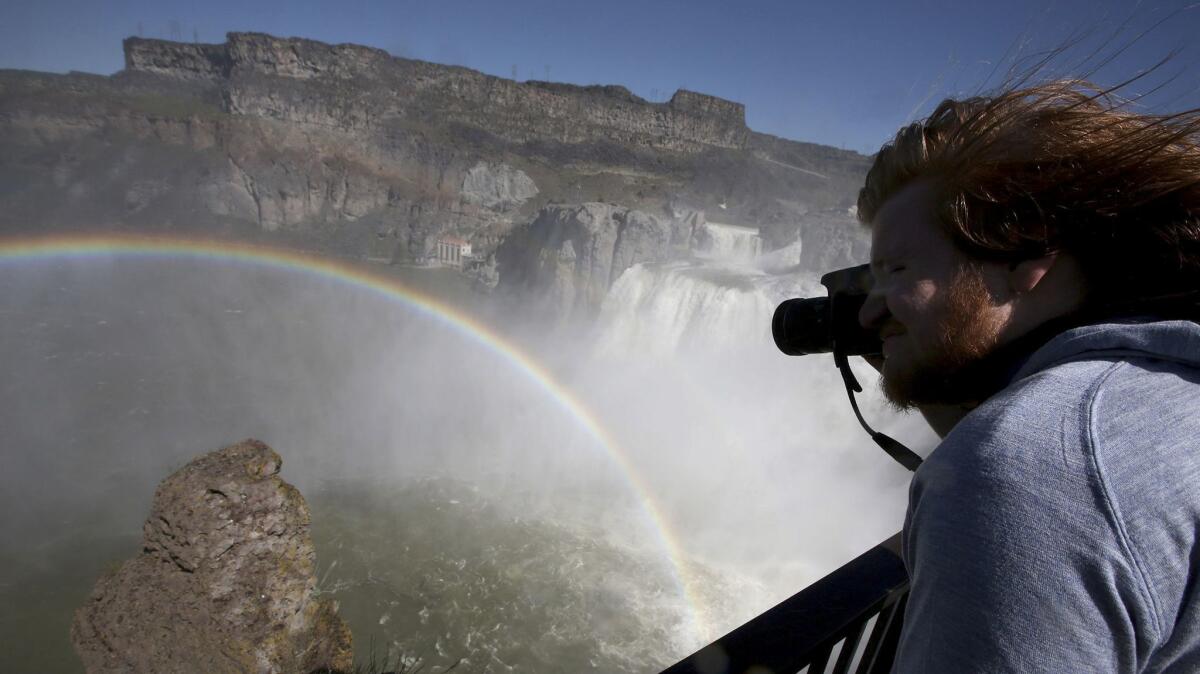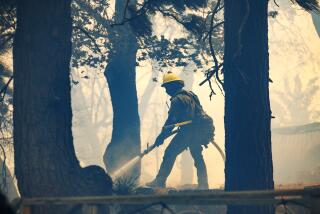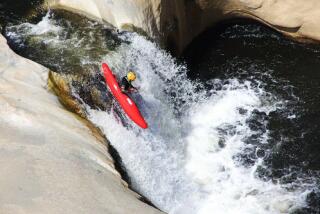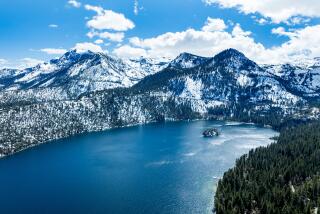A wet winter gives way to a sensational spring for viewing Idaho’s Shoshone Falls
Winding down the steep, narrow road alongside dark rock cliffs required a driver’s full attention. But then distraction appeared in the form of a bright rainbow.
Sharp and full, it arched over the Snake River not far from where Evel Knievel attempted to clear the canyon on a daredevil jump more than 40 years ago.
Windshield wipers were advised in the parking lot. It wasn’t raining. But rising from below was a heavy mist that kept trails, stairs and observation decks wet for months.
Then there was the sound, deep and thunderous. It’s felt more than heard.
Shoshone Falls — 900 feet wide, 212 feet high and dubbed “the Niagara of the West” — was putting on a show unlike it has in years. Water tumbled over its edge at a furious rate after an excessively wet winter. People came in droves to watch.
“It’s impressive,” said Henry Roberts, who grew up in Twin Falls and had come back from Albuquerque to take photographs, shielding his camera from the wet air. “I’ve never seen it like this before.”
Wendy Davis, Twin Falls parks and recreation director, said word had spread in late February that Shoshone was shaping up to be a spectacular spring sight. People began driving from Boise, Salt Lake City and eastern Oregon to catch it.
With the winter stretching into spring and the roads still icing up, one visitor crashed trying to get down to see Shoshone Falls. Emergency crews had a hard time reaching the accident. Since the road needed to be cleared anyway, the city decided to open the gate to the parking lot in in mid-March, two weeks earlier than usual.
Traffic “hit like a tidal wave,” Davis said. “It was incredible.”
More than 3,300 vehicles showed up that first weekend. The parking lots filled. Because the park bathrooms remained closed — it was still cold enough to freeze the pipes — everybody had to compete for the use of two portable toilets.
The next weekend, the crowd was even larger — 4,800 vehicles — worsening the bathroom crisis to the point that the police got involved.
Davis ordered more portable toilets and got crews to run heating devices along the pipes in order to open the restrooms.
“The police were threatening to shut it down,” Davis said. “For those first three weeks, porta-potties were the bane of my existence.”
Between 1998 and last year, park officials have deemed only three years “great water flows”: 2006, 2009 and 2011. Eight years were determined to be “low flow” and eight were considered average. In some years, the flow has been so low that rock has been visible.
This spring was off the chart.
Melissa Barry, executive director for Southern Idaho Tourism, a marketing group, said the water has been at the highest levels seen in two decades — cascading at a peak rate of more than 21,300 cubic feet per second.
That’s more than 70 times the minimum flow the park requires during the tourist season.
On its website, Southern Idaho Tourism began touting the falls’ impressive display so early in the season and featured a picture — complete with the rainbow glowing in the morning sun.

The falls are part of the 1,078-mile Snake River, which originates in Wyoming near Yellowstone National Park, cuts west through canyons and wide swaths of agricultural land and feeds into the Columbia River.
Barry said the winter was so wet that all of the agricultural needs had been met above the falls, leading to more water being released by dams into the Snake River.
But the excessive flow also wreaked havoc with other outdoor activities in the area. Paddle-boarding, swimming and fishing were delayed because of the swift currents created by the high water volume. Once fishing season starts, Barry said, it should be excellent, as high water flows increase spawning.
The revenue from admission into Shoshone Falls and nearby Dierkes Lake — $3 per vehicle — is already giving Davis an opportunity to consider fixing the roads and parking lots in the area as well as shore up some loose soil around the park.
Unlike many big natural attractions that are the domain of state or federal parks, Shoshone Falls is run by the city of Twin Falls. At 47,000 people, it’s a small city in rural Idaho that finds itself managing a regional, national and international attraction.
Its maintenance budget is solely determined by vehicle admissions, and in good years Davis manages to squirrel away money for future improvement projects.
The current maintenance budget is about $100,000 — slightly less than 10% of the total for the entire park.
For a small city and a small staff, keeping Shoshone Falls an international draw while maintaining it on a local budget is a challenge.
“From our mindset, we’re handling swing sets, managing ball fields and keeping city parks used for picnics maintained while also managing one of the largest tourist attractions in the state,” Davis said. “This isn’t your typical park.”
Thanks to Shoshone Falls, March and April brought the park a record $133,919 in revenue.
A windfall.
Twitter: @davemontero
ALSO
Some conservatives justify ‘manly’ Montana candidate’s alleged body-slam of ‘snowflake’ reporter
Alex Jones settles Chobani lawsuit and retracts comments about refugees in Twin Falls, Idaho
More to Read
Sign up for Essential California
The most important California stories and recommendations in your inbox every morning.
You may occasionally receive promotional content from the Los Angeles Times.











